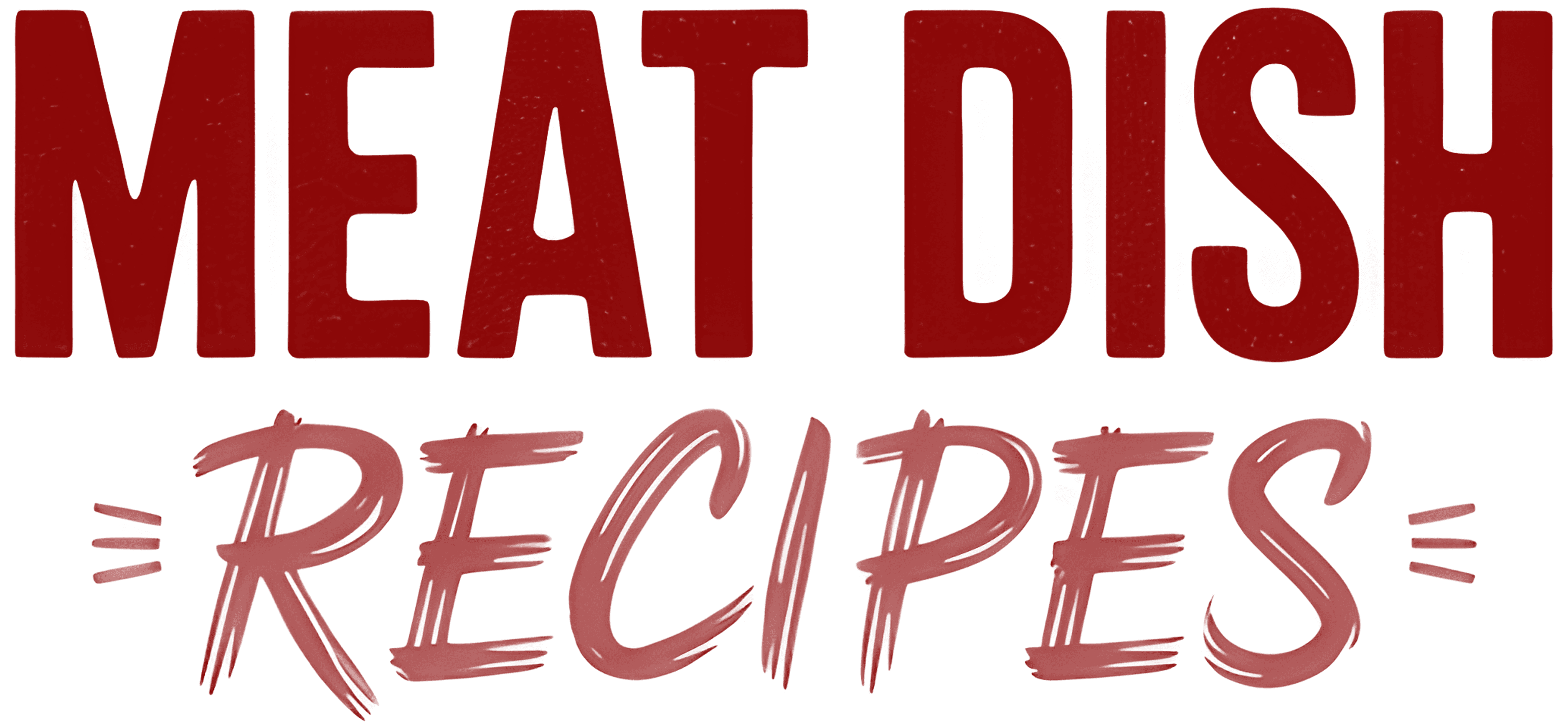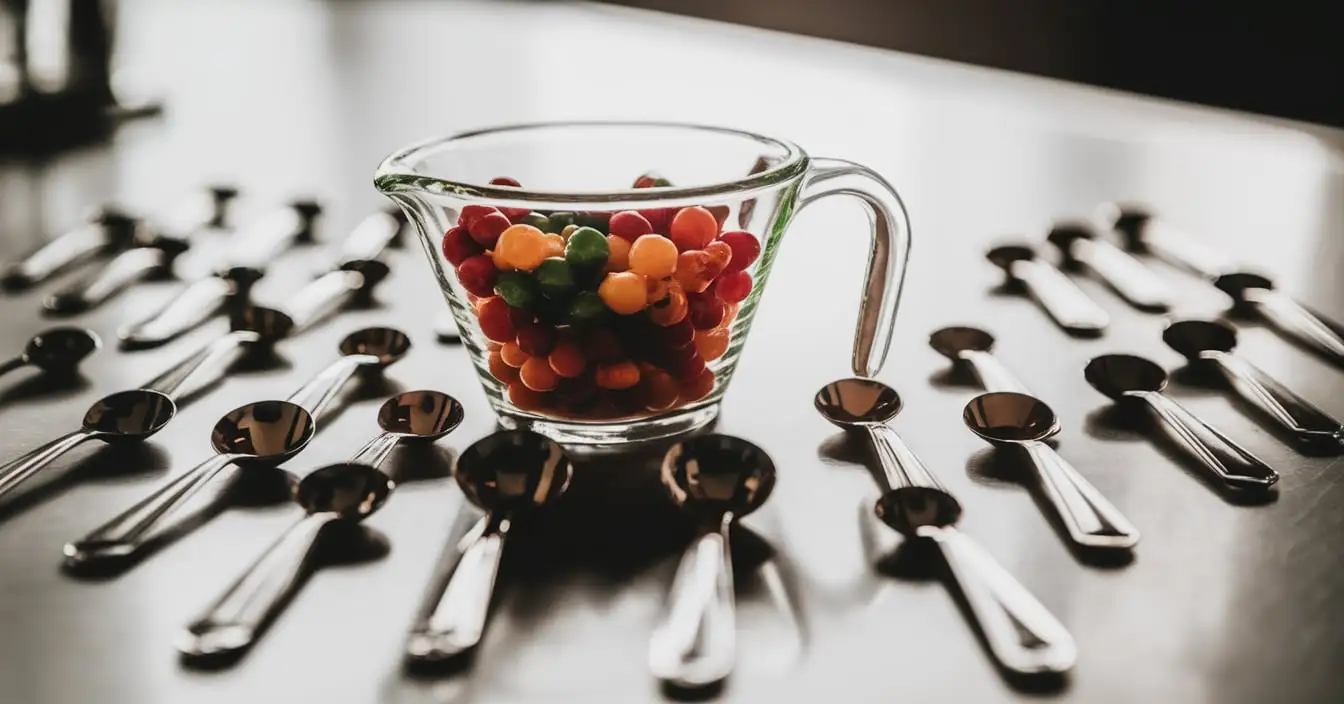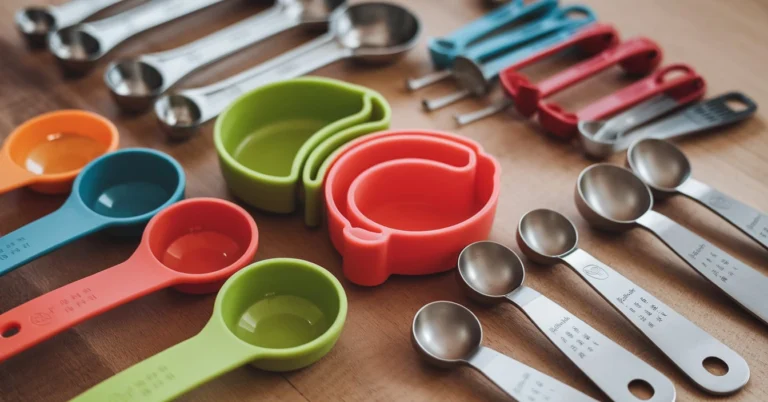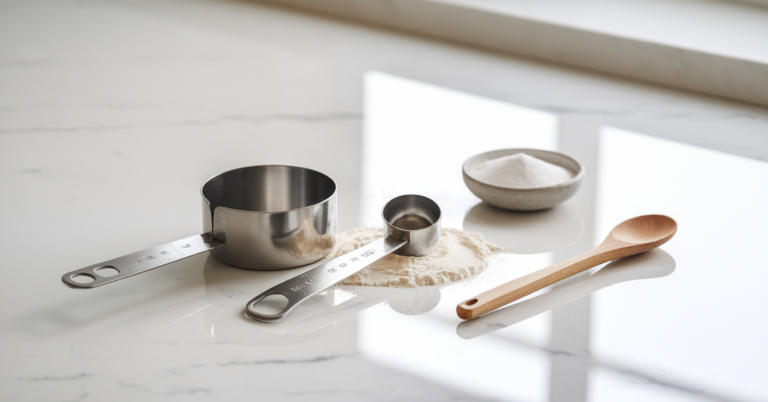How Many Tablespoons in 1/2 Cup
Ever found yourself confused in the kitchen, reading a recipe? You’re not alone. Whether it’s a family dinner or baking for school, knowing the right measurements is key. Knowing eight tablespoons in a 1/2 cup in the US helps you cook confidently.
This knowledge ensures that your dishes turn out just right, bringing out the flavors and textures you want in every bite.
Table of Contents
Understanding Cup Measurements
Knowing different cup measurements makes cooking better. It helps you get the right amounts of ingredients. Here’s a closer look at what a cup means in cooking and the types of measuring cups you can use.
Defining a Cup in Cooking
A cup is key in cooking and is used for dry and liquid ingredients. In the US, a standard cup is 16 tablespoons or 237 milliliters. This is why cup measurements are so important in cooking and baking.
For example, half a cup is eight tablespoons. It’s a key measurement for many tasty recipes.
Types of Measuring Cups: Liquid vs. Dry
It’s important to know the difference between liquid and dry measuring cups. They are used differently:
- Liquid measuring cups: These have a spout for easy pouring. They are made to hold 1 cup or more. They are good for measuring liquids like water, milk, and oils.
- Dry measuring cups: These are filled to the top and leveled off. They are used for dry ingredients like flour, sugar, and grains. A standard dry cup is usually 225 ml.
Choosing the right measuring cup is crucial. It can greatly affect your recipe, especially in baking. Getting the measurements right is what makes your dish turn out well.
How Many Tablespoons in 1/2 Cup
Knowing how cups and tablespoons relate can make cooking easier. Since 1/2 cup is the same as eight tablespoons, measuring ingredients correctly is key. This conversion helps avoid mistakes in the kitchen.
The Simple Conversion
One cup is 16 tablespoons, so half a cup is eight tablespoons. This information is handy for switching between different measurements in recipes. It makes it easy to adjust between teaspoons, tablespoons, and cups.
- From tablespoons to cups: Divide the number of tablespoons by 16.
- From cups to tablespoons: Multiply the number of cups by 16.
Visualizing Measurement Equivalents
Seeing these measurements can make your kitchen work better. Here’s a table showing how tablespoons and cups relate:
| Cups | Tablespoons |
|---|---|
| 1/4 Cup | 4 Tablespoons |
| 1/3 Cup | 5 Tablespoons + 1 Teaspoon |
| 1/2 Cup | 8 Tablespoons |
| 3/4 Cup | 12 Tablespoons |
| 1 Cup | 16 Tablespoons |
Using the right tools, like a tablespoon, is key for precise cooking and baking. Knowing these conversions lets you cook with confidence and make delicious meals.
The US Conversion Formula
Knowing the US conversion formula is key for precise Kitchen Calculations. It makes it simple to change cup measurements to tablespoons. Since each cup has 16 tablespoons, adjusting recipes is straightforward.
How to Calculate Tablespoons
To find the number of tablespoons in a cup, multiply the number of cups by 16. This method helps in Cooking Measurements. It keeps your dishes consistent, no matter the size. For instance:
- For 1/2 cup, multiply by 16 to get eight tablespoons.
- For 1/4 cup, you would get four tablespoons.
- In the case of 3/4 cup, the result is 12 tablespoons.
Common Conversions for Quick Reference
Quick references can be a big help in the kitchen. Here’s a simple conversion chart:
| Cup Measurement | Tablespoons |
|---|---|
| 1/8 cup | Four tablespoons |
| 1/4 cup | Eight tablespoons |
| 1/3 cup | 5 tablespoons + 1 teaspoon |
| 1/2 cup | 8 tablespoons |
| 2/3 cup | 10 tablespoons + 2 teaspoons |
| 3/4 cup | 12 tablespoons |
| 1 cup | 16 tablespoons |
Tablespoons Around the World
The idea of a tablespoon might seem simple, but it varies globally. Knowing these differences in Cooking Measurements can change how you cook. The volume of a tablespoon can differ, affecting the taste of international dishes.
Variations in Measurement Standards
In the US, a tablespoon is 15 mL. But it’s about 20 mL and 14.21 mL in Australia and the UK, respectively. This shows the importance of knowing the measuring system used in recipes.
International Tablespoon Values
It’s key to know the International Tablespoon Values to avoid mistakes. Here are some important comparisons:
| Country | Tablespoon Volume (mL) | Tablespoons per 1 Cup |
|---|---|---|
| United States | 15 | 16 |
| Australia | 20 | 12.5 |
| United Kingdom | 14.21 | 13.32 |
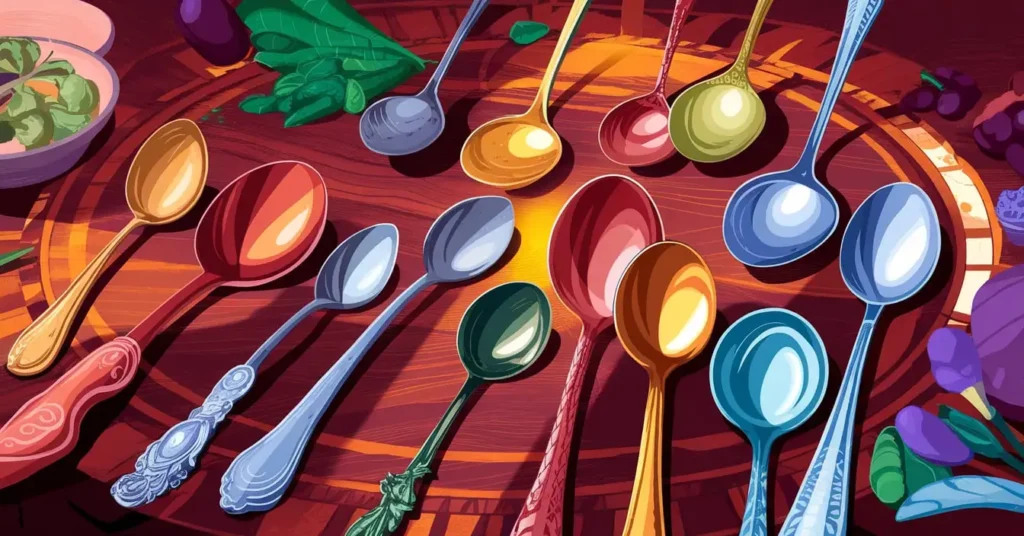
In short, while tablespoons are useful, their differences are important to remember. Knowing the measurement standards is crucial whether you’re cooking a recipe from abroad or trying new dishes.
Equivalent Value of 1/2 Cup in Tablespoons across Different Countries
Cooking Measurements can change a lot from one country to another. When looking at 1/2 cup in tablespoons, you see big differences. This is especially true between the US and countries using the metric system. Knowing these differences is key to ensuring your baked goods and meals turn out right, especially when using recipes from other places.
US vs. Metric System Differences
In the US, 1/2 cup is 8eighttablespoons. This makes it easy to measure both liquids and solids in recipes. However, countries that use the metric system have different rules. A metric cup is about 250 mL, close to 8 1/3 tablespoons. This shows how cooking can be different depending on where you are.
Comparative Equivalents for Global Cooking
Here are some examples of how Tablespoons can vary worldwide:
| Measurement System | 1/2 Cup (mL) | Equivalent in Tablespoons | Notes |
|---|---|---|---|
| US Customary | 118 mL | Ten tablespoons | 16 tablespoons in a full cup |
| Metric | 125 mL | 8 1/3 tablespoons | Based on 250 mL for 1 cup |
| UK Imperial | 284 mL | 10 tablespoons | Uses different volume standards |
| Australia | 250 mL | 12.5 tablespoons | Australian tablespoon size is 20 mL |
| New Zealand | 250 mL | 16 tablespoons | Uses similar tablespoons as the UK |
This detailed look shows why knowing global Cooking Measurements is important. Learning these conversions can make you a better cook. It also makes cooking recipes from other places more fun and successful. Knowing how to convert tablespoons helps you make tasty dishes, no matter where the recipe comes from.
Metric vs. Imperial Measurements
Knowing the difference between Metric and Imperial Measurements is key for cooking fans. The metric system is used worldwide and is based on multiples of ten. This makes it easier to convert and measure. On the other hand, the Imperial system, mainly used in the US, Liberia, and Myanmar, has different units that can be tricky.
Both systems are important in cooking. They affect how recipes are written and followed.
Definitions and Uses of Cooking
In the kitchen, precision is crucial. The metric system makes conversions simple. For example, a cup is 250 mL, whereas a US cup is about 237 mL.
This small difference can affect your cooking. Also, knowing that one US tablespoon is 15 mL helps with both systems. This knowledge helps you adjust recipes better.
Importance of Knowing Both Measurement Systems
Knowing both Metric and Imperial Measurements makes you a better cook. Recipes from around the world use different systems. For example, 1 ounce is about 28 grams in metric.
This knowledge helps you convert ingredients for dishes from other countries. It makes you more flexible in the kitchen. Understanding both systems leads to better and tastier cooking.
Liquid Conversions
Getting the right liquid measurements is key in cooking. It ensures your dishes turn out right every time. Liquid measuring cups help by showing both fluid ounces and cups. Always check the liquid level at eye height to get it right.
Understanding Liquid Measurement Differences
Accurate Liquid Measurements need you to know some key conversions. For cooking, these are the most important:
- 1 tablespoon = 15 ml
- One fluid ounce = two tablespoons or 29.6 ml
- 1 cup = 8 fluid ounces = 16 tablespoons
- 1/2 cup = 4 fluid ounces = 8 tablespoons
Converting Liquid Measurements to Volume
Changing liquid measurements helps keep recipes consistent. Here’s a table with common conversions:
| Measurement | Volume in ml | Volume in Cups | Volume in Tablespoons |
|---|---|---|---|
| 1/8 teaspoon | 0.5 | – | – |
| One tablespoon | 5 | – | 1 |
| 1 tablespoon | 15 | – | 1 |
| 1/4 cup | 50 | 0.25 | 4 |
| 1/2 cup | 125 | 0.5 | 8 |
| 1 cup | 250 | 1 | 16 |
| 1 quart | 946 | 4 | 64 |
Ehren’s Measuring Tips
Accurate cooking needs precision. Knowing how to measure ingredients right is key to success. Can improve your Kitchen Calculations and Cooking Measurements. by following some essential tips. This will also make your cooking better.
Fluffing Dry Ingredients: Why It Matters
Fluffing dry ingredients, like flour, is very important. It helps break up clumps, giving a more accurate measure. This small step can greatly change your recipe’s outcome.
Measuring flour wrong can make the dough too dense or too thin. This affects your final dish a lot.
Choosing the Right Measuring Tool
Choosing the right measuring tool is also key for accurate Kitchen Calculations. For dry ingredients, use level measuring cups. A digital kitchen scale is best for ingredients like butter or chocolate chips, where small differences matter.
Knowing the right tools and methods can make your dishes tasty and consistent, leading to better results and success in cooking.
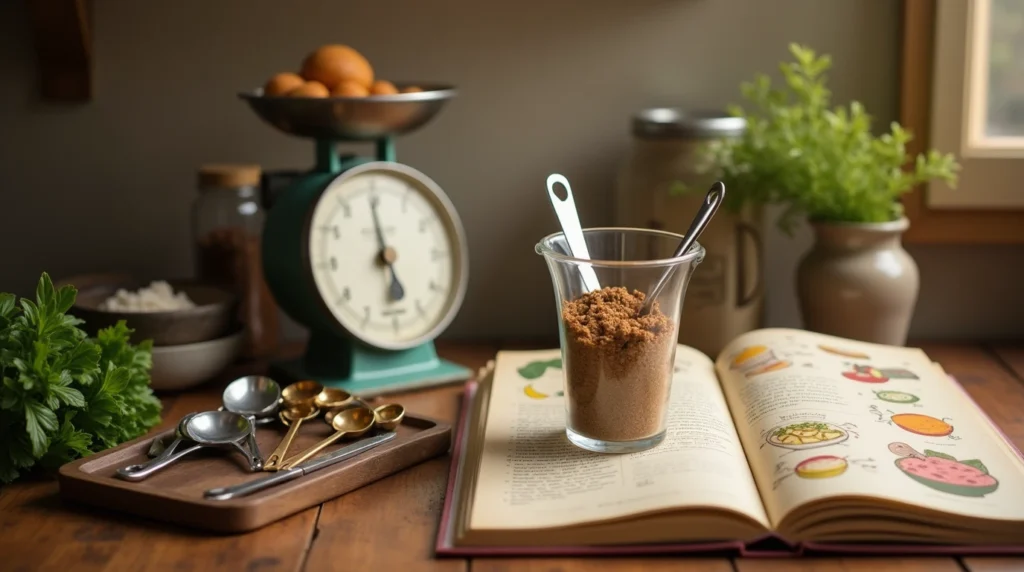
| Ingredient | 1/2 Cup (US) | Equivalent (grams) | Equivalent (ounces) |
|---|---|---|---|
| Almonds (Flaked) | 1/2 cup | 45g | 1.5 oz |
| Butter & Margarine | 1 cup | 225g | 8 oz |
| Golden Syrup | 1/2 cup | 170g | 6 oz |
| Granulated Sugar | 1 cup | 200g | 7.1 oz |
| Chocolate Chips | 1 cup | 150g | 6 oz |
Conclusion
Learning to convert tablespoons to 1/2 cup is key for cooking and baking. Knowing there are 16 tablespoons in a US customary cup helps. This means 1/2 cup is equal to 8 tablespoons.
This knowledge makes cooking easier and boosts your confidence. You can try new recipes and get the flavors and textures right.
Being precise with measurements is crucial, especially in baking. Small changes can make a big difference. Using the right tools helps you succeed, whether it’s a family recipe or something new.
Knowing these conversions is the first step to better cooking. It makes your time in the kitchen more enjoyable and efficient. So, let these conversions help you become a better cook and explore new recipes.
